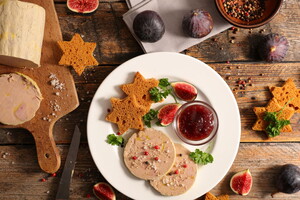7 things you need to know about foie gras to shine on New Year's Eve

Foie gras is an emblematic product of Landes culture and gastronomy. But how much do you know about this exceptional delicacy, which is as delicious as it is controversial? Here are seven things you need to know to enjoy it better and show off your science on New Year's Eve!
South-West France is the birthplace of foie gras
Not true! Although the Landes department is the leading producer of foie gras in France, producers in Alsace and the Landes are disputing the paternity of French foie gras. It was invented in 1778 by Jean-Pierre Clause, a chef from Strasbourg who worked for the Maréchal de Contades, despite the fact that we Landais don't like the idea.
Where does foie gras come from?
Contrary to what you might think, it was neither the Landais nor the Alsatians who "invented" foie gras. Its history began in ancient Egypt, 5,000 years ago! The banks of the Nile were a major route for the migration of wild geese and ducks. This was not lost on the Egyptians. Scenes of force-feeding dating from around 2500 BC can be seen on a necropolis at Saqqarah, near present-day Cairo.
Foie gras is part of France's cultural and gastronomic heritage
Firmly rooted in local traditions, foie gras is synonymous with festive pleasure and attachment to the land. In 2006, it was officially recognised as part of France's "protected cultural and gastronomic heritage". Proof that the French are very attached to this refined dish is the fact that foie gras is one of the top 3 products eaten during the festive season, along with oysters and smoked salmon.
What's the difference between duck foie gras and goose foie gras?
Your guests may not know the difference, but the taste is different! Duck foie gras (the most commonly eaten) has a stronger, more powerful flavour with a longer finish. Goose foie gras is reputed to be finer and more delicate on the palate. It is also generally more expensive to buy.
Making foie gras without force-feeding: possible or not?
A number of producers have recently started making organic goose foie gras without force-feeding. Born and reared in the wild, the geese eat corn all day long. They are fed as much as they want. Force-feeding is an innate behaviour in geese. Indeed, the accumulation of fat in the liver is a natural mechanism observed in geese and ducks. This overfeeding enables them to withstand the rigours of winter and complete their long migration.
Does foie gras make you fat... a little, a lot, passionately, madly?
Yes and no, because no food makes you fatter than another. However, the calorie content of foie gras is not negligible: around 500 kcals per 100 g! So you can treat yourself from time to time, as long as you don't eat it every day.
How much does foie gras cost?
The price of foie gras per kilo varies between around €28 and €35. However, the drop in production, particularly as a result of bird flu, can cause prices to soar. Some products trade at around 60 euros per kilo. Raw duck foie gras is on average 40% cheaper than cooked foie gras, but it has to be prepared and, above all, deveined (the veins removed from the lobe of the liver), which is no mean feat.




